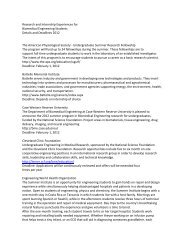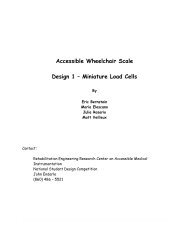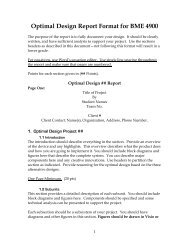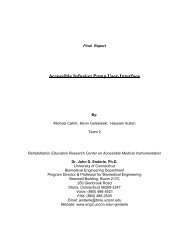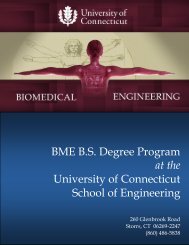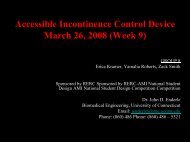Accessible Infusion Pump User-Interface - Biomedical Engineering ...
Accessible Infusion Pump User-Interface - Biomedical Engineering ...
Accessible Infusion Pump User-Interface - Biomedical Engineering ...
You also want an ePaper? Increase the reach of your titles
YUMPU automatically turns print PDFs into web optimized ePapers that Google loves.
Karin Garmer 1 , Erik Liljegren 1 , Anna-Lisa Osvalder 1 and Sven Dahlman 1(1) Department of Human Factors <strong>Engineering</strong>, Chalmers University of Technology,Göteborg, SwedenAbstract Objective.There is a need to develop adequate methods for useby themanufacturers of medical equipment when specifying requirementsfor theirdevelopment and in order for hospitals to critically assesstheir usability qualities beforepurchase. A Human Factors approach wasused to determine requirements for theredesign of an existingvolumetric infusion pump. With these requirements as a startingpoint, anew user interface for an infusion pump was designed. Usability testswerecarried out to verify whether the new interface had betterusability than the existinginterface or whether further improvementswere needed. This paper has two aims: 1) tocompare the nature of therequirements derived from a Human Factors approach andfrom usabilitytests and 2) to evaluate the use of usability tests on existingmedicalequipment as a basis for redesign and for evaluating the redesign.Method.Theuser requirements derived from the Human Factorsapproach were compared with theuser requirements derived from theusability tests.Results.The results show that therequirementsderived from the Human Factors approach adequately coveredcontextualaspects of use. However, to derive requirements for a specificandoperational level, usability tests must be conducted on existingequipment andprototypes. This study indicates that usability tests onexisting medical equipment as abasis for redesign give a betterunderstanding of problems with existing equipment.Moreover it isimportant to carry out usability tests to evaluate a redesign and findasatisfying solution. Expert users of the equipment had the experience,competenceand confidence to be critical and suggest improvements basedon their practicalknowledge. The novice users on the other hand wereimportant test users as theyuncovered most of the serious handlingproblems and also committed most errors.Conclusion.Therequirements derived from the Human Factors approach and theusabilitytests are important for the development of a new and improved userinterface.The requirements derived from the Human Factors approach canbe attributed tocontextual requirements. The requirements derived fromthe usability tests have ahigher degree of concreteness, are morespecific and focus more on design solutionscompared to the requirementsderived from the Human Factors approach. It isimportant to considerintended user groups when carrying out usability tests, as thenature ofthe information from the different groups can be different.Garmer, Karin, Erik Liljegren, Anna-Lisa Osvalder, and Sven Dahlman. "Arguing for theNeed of Triangulation and Iteration when Designing Medical Equipment." Journalof Clinical Monitoring and Computing Feb 2002 105-114. 01 Oct 2006 .3.) Heuristic evaluation of infusion pumps: implications for patient safety inIntensive Care Unitshttp://www.sciencedirect.com/science?_ob=ArticleURL&_udi=B6T7S-4DFNFCM-3&_coverDate=11%2F01%2F2004&_alid=459109074&_rdoc=1&_fmt=&_orig=search&18




